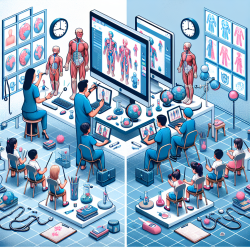Introduction
The COVID-19 pandemic has forced numerous industries to adapt rapidly, and the medical field is no exception. A recent survey conducted on Canadian pediatric hospital clinical/medical teaching units (CTUs) during the pandemic's first and second waves has revealed fascinating insights into how these units have adapted their practices. This blog explores the key findings of this survey and offers practical advice for practitioners looking to enhance their skills and adapt to the evolving landscape of medical education.
Survey Findings: A New Era for Clinical Teaching Units
The survey conducted by infectious disease specialists and pediatric hospitalists highlighted the variability in adapting rounding practices during the pandemic. Here are some key findings:
- During the first wave, sit-down rounds became more common, with virtual rounds being utilized by 44.4% of hospital CTUs.
- Medical students were restricted from participating in rounds involving COVID-19 positive or suspected patients.
- After the first wave, most hospitals planned to conduct bedside rounds with a maximum of four individuals.
- During the second wave, 50% of respondents conducted bedside rounds with a maximum of four individuals, showing a shift from virtual to more traditional methods.
Lessons Learned and Opportunities for Improvement
The survey results highlight several opportunities for practitioners to improve their skills and adapt to the new normal:
- Embrace Technology: The shift to virtual rounds has shown that technology can be a powerful tool in medical education. Practitioners should explore online platforms for synchronous and asynchronous learning to enhance their teaching methods.
- Focus on Communication: The pandemic has underscored the importance of clear communication among multidisciplinary teams. Practitioners should prioritize effective communication strategies to ensure patient-centered care.
- Adapt to Changing Guidelines: With the pandemic's unpredictable nature, practitioners must remain flexible and ready to adapt their practices to new guidelines and restrictions.
Encouraging Further Research
The survey's findings also point to the need for further research in several areas:
- Long-term Impact of Virtual Rounds: While virtual rounds have been effective during the pandemic, more research is needed to understand their long-term impact on medical education and patient care.
- Best Practices for CTU Implementation: As the pandemic evolves, developing best practices for CTU implementation will be crucial in ensuring effective medical education and patient care.
Conclusion
The COVID-19 pandemic has transformed pediatric clinical teaching units in Canada, offering valuable lessons and opportunities for practitioners to improve their skills. By embracing technology, focusing on communication, and remaining adaptable, practitioners can navigate the challenges of the pandemic and continue to provide high-quality medical education and patient care.
To read the original research paper, please follow this link: A survey on Canadian pediatric hospital clinical/medical teaching unit implementation during the first and second wave of the COVID-19 pandemic.










